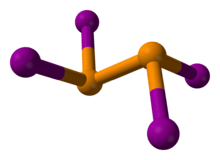Subhalide
In chemistry, subhalide usually refers to inorganic compounds that have a low halide:metal ratio, made possible by metal–metal bonding (or element–element bonding for nonmetals), sometimes extensive. Many compounds meet this definition.

P2I4 is a subiodide of phosphorus.
Examples
The normal halide of boron is BF3. Boron forms many subhalides: several B2X4, including B2F4; also BF. Aluminium forms a variety of subhalides. For gallium, adducts of Ga2Cl4 are known. Phosphorus subhalides include P2I4, P4Cl2, and P7Cl3 (structurally related to P73−). For bismuth, the compound originally described as bismuth monochloride was later shown to consist of Bi95+ clusters and chloride anions.[1] There are many tellurium subhalides, including Te3Cl2, Te2X (X = Cl, Br, I), and two forms of TeI.[2]
gollark: It's actually REALLY HARD to cheaply move this much energy around the compact machine.
gollark: https://osmarks.tk/random-stuff/maxim/Access a random one via this convenient API!
gollark: Ah, the maxims of maximally effective mercenaries, yes.
gollark: ```RF Gen in the Billions,Item/Fluid/RF Storage in the 2^63-1 Cross dimensional Storage-Storage transport (for the Infinity Containers Only)```*No.*
gollark: Sounds OP.
References
- Greenwood, Norman N.; Earnshaw, Alan (1997). Chemistry of the Elements (2nd ed.). Butterworth-Heinemann. ISBN 978-0-08-037941-8.
- Zhengtao Xu "Recent Developments in Binary Halogen–Chalcogen Compounds, Polyanions and Polycations" in Handbook of Chalcogen Chemistry: New Perspectives in Sulfur, Selenium and Tellurium, Francesco Devillanova, Editor, 2006, RSC. pp. 381-416. Royal Society doi:10.1039/9781847557575-00455
This article is issued from Wikipedia. The text is licensed under Creative Commons - Attribution - Sharealike. Additional terms may apply for the media files.